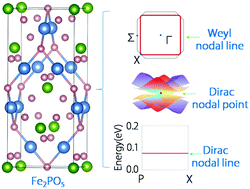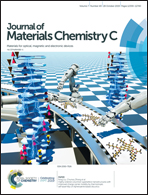Topological nodal lines and nodal points in the antiferromagnetic material β-Fe2PO5†
Abstract
Topological metals/semimetals, as novel topological states of matter, have been well investigated in nonmagnetic and ferromagnetic materials. Here, by performing band structure calculations, we report the discovery of rich topological states in an antiferromagnetic metal β-Fe2PO5. When spin–orbit coupling (SOC) is not considered, it hosts a Weyl nodal line, Dirac point, and Dirac nodal line near the Fermi level. In particular, the Weyl nodal line in β-Fe2PO5 is formed by the crossing bands from a single spin channel. Such a fully spin-polarized Weyl nodal line has not been identified in realistic AFM materials before. The Dirac point and Dirac nodal line in β-Fe2PO5 occur in a specific high-symmetry path, and are formed by the crossing bands from both spin channels, showing different signatures with the Weyl nodal line. When SOC is taken into account, the Weyl nodal line is retained, and the Dirac nodal point and nodal line degenerate into their Weyl counterparts. The existence of rich fermionic states in antiferromagnetic β-Fe2PO5 not only provides an excellent platform to study the entanglement between magnetism and topological states, but also shows great potential in topological antiferromagnetic spintronics applications.



 Please wait while we load your content...
Please wait while we load your content...